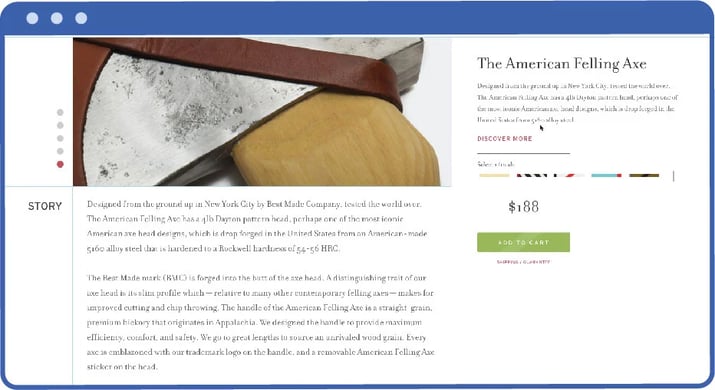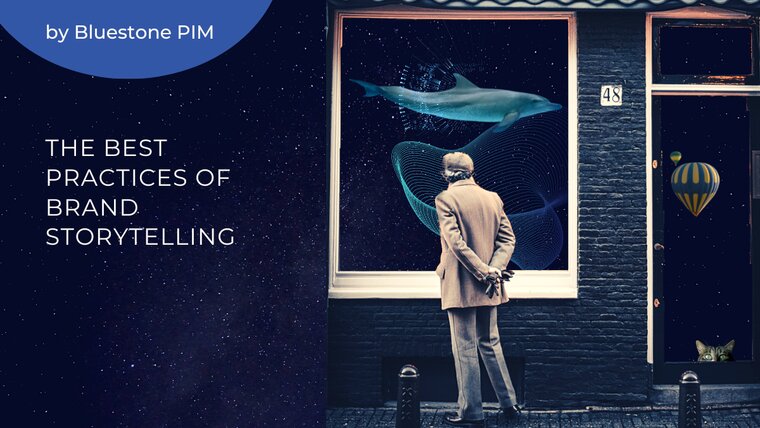The Beginner’s Guide to Effective Product Storytelling

Author, entrepreneur, and marketer Seth Godin once said: “Marketing is no longer about the stuff that you make, but about the stories you tell.”
Therefore, storytelling skills are no longer something nice to have, but a must for both marketers and product managers who are responsible for driving online sales. Yet, not everyone is born with a natural gift for telling a great story.
If you fall into this group, however, we have good news for you – you’re still able to produce a compelling story about your product!
Just follow these 5 golden rules:
- Rule 1: Set up a content marketing strategy
- Rule 2: Don’t “borrow” product descriptions
- Rule 3: Keep it simple, stupid!
- Rule 4: Speak customers’ language
- Rule 5: Engage your teammates
Why Does Storytelling Work?
Who doesn’t like a good story? One that resonates with the audience, inspires people to take action, entertains, and teaches at the same time?
For example, a classic tale in which a noble character is pursuing a clearly defined goal in the face of a dangerous challenge. After all, we were all raised on such stories when our parents read them to us before bedtime.

Also, did you know that when you’re really invested in a story, your brain physically responds to it? It’s a biological reaction.
That’s why almost every book you’ve ever read and almost every movie you ever watched are based on the same three-act structure – they have a beginning, a middle, and an end.
And there’s no reason not to use the same storytelling strategy in business. In fact, there’s every reason for it.
Today, telling a great story is a critical part of building your brand. It allows people to quickly understand why your products matter.
Do it right, and you’ll quickly create an emotional connection between the customers and your brand. That’s what a successful product experience is all about.

DOWNLOAD FREE E-BOOK
The Art and Science of Customer Experience
Over 50 pages of expert advice and top CX tips
5 Golden Rules for Great Storytelling
Even if you’re not a natural-born storyteller, it’s not that difficult to tell an interesting story about your product, especially once you get familiar with these few basic storytelling rules:
Rule 1: Set up a Content Marketing Strategy
Posting evergreen blog posts, publishing engaging social media posts, organizing knowledge-filled webinars, or making high-quality videos. That’s a lot of work. But rather than watching how other companies create quality content, you should establish your own content marketing strategy.
Content marketing is the art of understanding what your customers need to know and delivering it to them in a relevant and compelling way to grow your business.
However, you can’t start building a content strategy if you don’t have a team to actually do the work, right? That’s why people are your most important asset and a talented marketing team that works well together is essential to achieving amazing results.
Rule 2: Don’t “Borrow” Product Descriptions
The worst thing you can do while trying to put together a product page that converts is to visit the manufacturer’s website and “borrow” the ready-to-use product description.
First of all, there are copyright issues, as some manufacturers don’t allow retailers to use their descriptions and images. Even if nobody pays attention to it today, you might get in legal trouble later.

Secondly, besides the moral aspects of such obvious copy-paste, congratulations – you just became the 37th seller who used the same boring description! How are you planning to stand out from the crowd now?
But there’s another reason you should write your own descriptions, and this is the most important one. It’s called a search engine.
You need to remember that Google rewards unique content. Therefore, if you give Google something new to tell about a specific product, it will help your webshop climb the search results ladder.
Rule 3: Keep It Simple, Stupid!
Don’t be afraid to tell a simple story. Just do it well. Stick to the Keep It Simple Stupid (KISS) principle and use this proven three-act structure:
- Beginning: Explain the problem that you want to solve.
- Middle: Describe how your product solves the problem.
- End: Show the success story and point out the product’s benefits.
While you may love the complexity of the Game of Thrones plot, you can’t expect people to appreciate the same thing in your product story.
In this case, simplicity works better because people remember a simple story faster and more deeply than a convoluted one. That’s human nature.
Unfortunately, many marketers totally forget about this golden rule.
Instead of taking the reader from point A to point B, they overcomplicate the story and muddy it with redundant decorations, frequent plot twists, and irritating CTAs. Guys, it’s completely unnecessary!
If you are a retailer who's trying to create some product descriptions, try doing something more creative instead of relying on a plain text. For example, insert a vlog or a 3D model. Sometimes it's better to show the product once instead of writing 1000 words about it.
Rule 4: Speak Customers’ Natural Language
Getting the language right is the only way to make your potential customers listen to you. It’s no secret that senior-level executives expect a different message than tech-savvy Millennials.
So, before you write anything about your product, ask yourself these questions:
- Who do you want to sell it to?
- What do they do?
- What are their burning consumer pain points?
In the world of marketing, this approach is known as finding your buyer persona.
Also, no matter who you communicate with, don’t try to impress people with great knowledge of difficult words. Make sure your writing is down-to-earth, easy to understand, and humorous at the same time.
Rule 5: Engage Your Teammates
The obvious truth is that without customers you have no business. That’s why every e-commerce company puts the customer at the heart of its business. But what about your team? Do you pay as much attention to them as well?
Well, you should because it’s extremely important that your colleagues are passionate about the positive impact of your products on the businesses of your customers. It’s the only way to increase employee satisfaction and turn employees into ambassadors.
“If you look after your staff, they’ll look after your customers. It’s that simple.”
So, the next time you run a 30-minute all-hands meeting, don’t just briefly inform people about the company’s status. “This month, we managed to do this, and next month we’re focusing on that. Now some HR announcements.” It’s hard to expect stellar results after presenting such dry and uninspiring messages.
Try to use some storytelling in your presentation to build true employee engagement. For example, instead of just summarizing what happened, take your time to explain why it happened and then outline the desired outcomes for the months to come.
Ready to Tell Your Story?
Now that we’ve explained the fundamentals of product storytelling, you really should read this quote:
You can have a great product, but a compelling story puts the company into motion.
We couldn’t agree more. So, make storytelling the cornerstone of your content marketing activities. Don’t try to copy what your competitors are doing. Establish your own content strategy to introduce a fresh voice into the discussion. Google will reward you for that, no doubt about that.
Also, before you start writing the story about your product, do your homework and try to understand your customers better. This will help you to tell a story that is meaningful not only to you but, more importantly, to your prospects.
Once you have grasped the fundamentals of product storytelling, you can make boring products sound awesome! Don't believe us? Check out our 5 Examples of Great Storytelling Tactics for Boring Products article to learn how some companies accomplished just that!
This piece is the fourth installment of our series on how to create a great customer experience.
Previously we shared tips to practice a customer-first mindset. Next time, we’re going to present you with a few creative storytelling tactics for boring products. Stay tuned!
Interested in product information management, but not sure where to start? Contact us to learn how a PIM solution can boost your e-commerce strategy.




